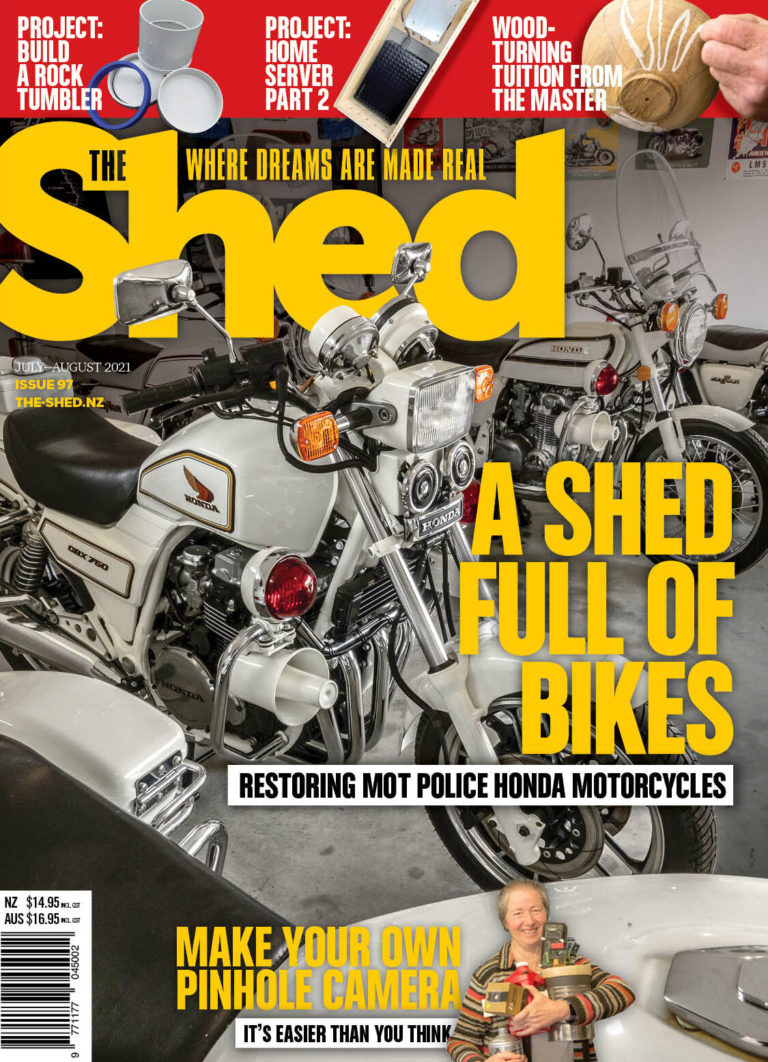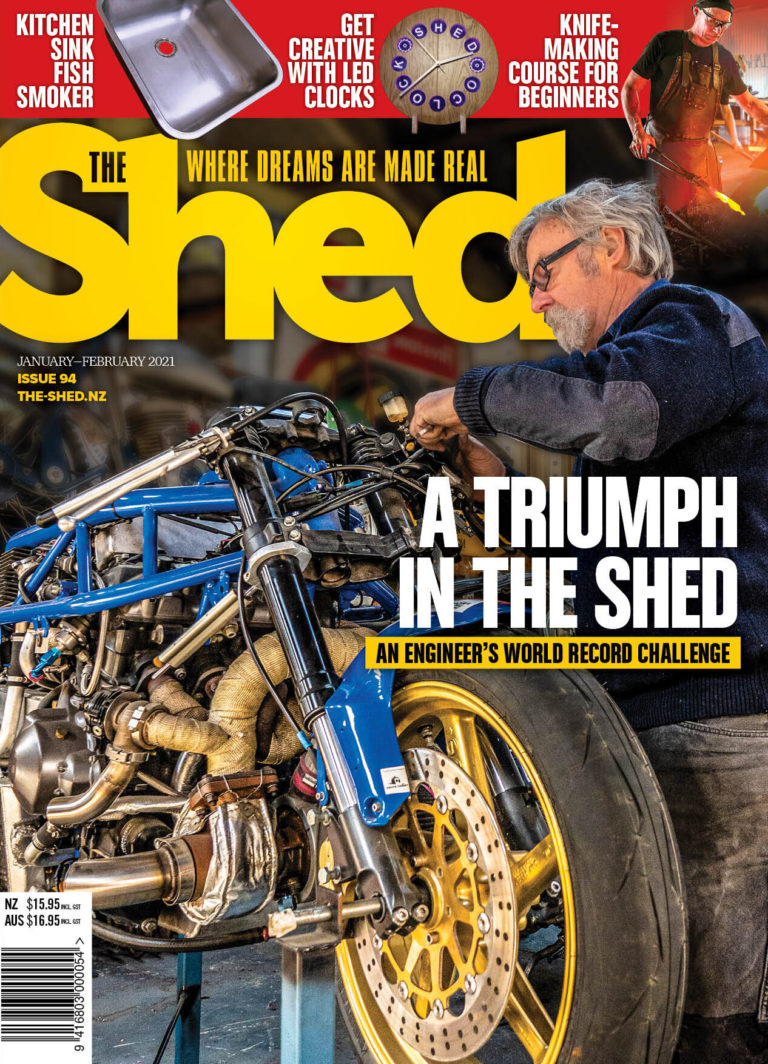The first part of making a small steam engine
By Robin Overall
The boiler .
A small steam engine has long been the ultimate aim of every amateur engineer, though I never thought I was included in this category.
During the late 19th century and well into the last, steam engines were a popular pastime for many people. Originally devised as a plaything for young boys, they quickly became the sort of toy that a lad was only allowed to play with on special occasions. They returned for a brief period of popularity during the 1960s and 1970s but even then were more adornments for a bookcase rather than well-used toys. This was probably due to the exorbitant cost of the product rather than any regard for safety.
They are an extremely attractive toy and fairly easy to make in the average workshop. However a recent stint at Rangitoto College as a technology teacher threw me in at the deep end. My predecessor had embarked on a unit of work that involved a group of Year 13 boys constructing steam engines in order that they could achieve NCEA grades in Brazing and Welding. I will confess that I am an amateur lathe operator and still have a huge way to travel on the learning curve.
Impressive
Many of the boys had made their boilers by the time I took over and they varied both in style and degree of ingenuity. Some had opted for the horizontal model and others had chosen to go vertical, with flue tubes down the middle. The level of competence was quite impressive and they generally had a good grasp of the basic concepts involved in the operation of a steam engine.
The principle of a steam engine is fairly basic but quite spectacular. Water when heated produces steam and the volume occupied by the steam is vast compared to the volume occupied by the water. A cup of water when boiled will produce enough steam to fill the whole room. This increase in volume when fed into the steam engine will produce pressure in the cylinder, which in turn will force the piston out.
The movement of the piston is constrained by the con rod being connected to a crank wheel. The crank wheel is on the same shaft as a flywheel. The momentum of the flywheel causes the crank wheel to carry on turning and this pushes the piston back into the cylinder thus expelling the spent steam. Because the cylinder is free to oscillate, the opening in the cylinder alternates between an inlet port and outlet port.
We then tackled the problem of constructing the actual engine. This proved to be a more demanding task and one that had to be simplified if we were to complete the project within the given time-frame.
I have divided the project into two areas. The boiler construction is covered first and then the engine. The reasoning behind this is that the boiler can be used with any similarly sized engine and vice versa, so once you are hooked who knows how many beautiful little models will be gracing the shelves of your shed.
The boiler tube (left) beside end Welch plugs.
Boiler
The boiler used in this model is constructed from a 100 mm length of 50 mm diameter copper pipe. This is the type of pipe that is used for sink wastes in older houses. You could use 40 mm copper if you can’t get 50 mm but just make it a tad longer to accommodate sufficient water. This model was made from a piece cut from an old waste trap which had been replaced by a new plastic one. This is still reasonably easy to obtain in short lengths from plumbers who have off-cuts that they may be prepared to sell.
The end plates can be made from the same material if it is annealed and cut to shape and then flattened. They can also be made using a former, to produce slightly domed end plates. The former can be made from either metal or hardwood and the copper is shaped over it.
Turn the former down to a diameter equal to the internal diameter of your tube minus twice the thickness of the copper sheet. The end result is a domed cap that fits in-side the tube and results in a neater finish than merely using disks of copper. It also looks more professional and adds considerably to the strength.
Welch plugs
Another alternative that I have opted for and will appeal to many people is to use pre-formed end caps. These are actually Welch plugs used in engine blocks, constructed from solid brass and are available for around $5 each from automotive accessory stores. (If you use 40 mm tube you will have to drift out the ends to accommodate the 40 mm plugs.) The copper tube is cut to the required length and the ends filed square. Use a de-burring tool to clean up the edges. These produce a really neat edge and are quite cheap to buy.
The boiler can be hard-soldered or it can be soft-soldered. This depends on the equipment you have access to and to a certain extent your skill level. The pressures reached with this boiler are way below the danger threshold when either method is used, so use whichever method you are most comfortable with. Ensure that all surfaces are clean and free of grease etc. It is a good idea to wipe the surface with industrial alcohol to ensure it is really clean.
With soldering it is desirable to “tin” the surfaces to be joined first and then, when they are positioned correctly, apply the minimum amount of solder to ensure a good bond. An oxy/acetylene torch is a tad vicious for this and I prefer to use an air / LPG torch, fitted with a pencil point burner.
The boiler is equipped with a filling hole, a steam outlet pipe, a water level plug and a safety valve. An optional extra is a whistle, which acts as a pressure release valve when needed.
From left, boiler holes for level check (in end), filling, steam outlet, safety valve.
Safety valve
The safety valve is constructed from a brass bolt, a short length of hexagonal brass rod, a ball bearing and a small spring. It is fairly simple to make with minimal lathe skills. The principle is to drill the bolt and then cut it into two pieces. Face off the cut ends. The length of hexagonal rod is drilled its entire length and each end tapped to accommodate the two halves of the bolt. The ball bearing sits over the hole in the lower bolt half and is held under pressure by means of a spring made from stainless steel wire, or in my case salvaged from a ballpoint pen. The whole assembly is located in a nut soldered to the copper tube.
The filler cap is much the same as the safety valve in as much as the brass bolt is located in a nut soldered to the copper tube. The provision of small O-rings on both the safety valve and the filler cap ensures a good tight seal in both cases.
The water level plug is mounted in the centre of one of the end plates. It can be a simple bolt in a soldered nut that is left undone when filling the boiler thus ensuring that the level of the water does not exceed the half-way mark. A better version is to drill the bolt for most of its length and then drill at right angles through the thread part way down from the top. This allows the bolt to be undone gradually and when water weeps out tighten it up again. By this means the water level can be checked when under steam.
A simple way of creating a safety “valve” is to simply replace a short length of the copper tubing from the cylinder to the inlet port with rubber tubing.
The steam outlet pipe can be soldered directly to the boiler and this would prove to be perfectly functional but the perfectionists amongst you may like to use a union nut and thus en-able it to be removed at a later date if required. This can be achieved by cutting a connecting nipple in half. It is then filed and soldered to the boiler with the cut end in contact with the boiler and the thread facing upwards. A corresponding olive and nut complete the connection. The 1/8-inch nipples are available from engineering supply firms and are amply long enough to be cut in half.
Steam outlet pipe uses union nut, nipple, olive and nut.
Stand
I constructed the boiler stand from four pieces of 3 mm mild steel. It could be made as one piece and folded or made from aluminium or brass. Drill three 15 mm holes in each of the long sides to enable air to reach the burner. I brazed the pieces together after cutting to size.
The finished stand was ground and sanded and sprayed with sandable primer and then a coat of matt black Hi-temp paint. The addition of two lugs to the base means it can be fastened to a wooden base. Two strips of brass were filed to size, polished, drilled and fastened over the boiler to hold it in position, with 6 gauge self-tapping screws. The finished model is mounted on a piece of wood (I used an off-cut of elm), which has been sanded and waxed. If the piece is intended as a present for some lucky young person, the addition of a small brass plate suitably inscribed would be a nice gesture.
Steam tubing
I have used 1/8-inch copper tubing as the union nuts and fittings are readily available from engineering supply specialists. There is no need to make these, as the skill level is extremely high and after all “Why reinvent the wheel?” Copper is easily worked if it is annealed. Hold it in a pair of pliers and heat it to dull red and then plunge in cold water. It will then be soft enough to bend any way you wish. As you bend it, work hardening will take place so you may have to repeat the process. The copper tubing is best cleaned with steel wool and then polished with brasso. Brass nipple connectors could also be used on the engine stand but I think it is unnecessary. This will be covered in the next part of this article. Try to keep all pipe work vertical or horizontal in elevation and all changes of angle made in the plan view. This aids considerably in giving your model a professional image.
William Lin at Rangitoto College…impressive student work.
Burner
The fuel used is methylated spirit and a suitable burner needs to be constructed. This can be made from either copper or steel. I have used copper as it avoids the problem of rust. Methylated spirit does not necessarily need a wick but the fuel efficiency can be greatly enhanced by using wicks. Wick mate-rial is easily available from camping shops and most hardware stores. Depending on the type of wick, the top of your burner can be modified accordingly.
Optional extras
Although I have not included any extras on my model I have made some that may find a place on a future model. These include things such as oilers, taps, switches and a whistle. The whistle is perhaps the simplest and most fun.
Silver solder.
JONATHAN’S SCHOLARSHIP
Small steam engines and budding engineers certainly go together. A small steam engine piqued the interest of 15-year-old Kristin School student Jonathan Feist who is showing all the signs of heading for an outstanding career in engineering. In 2007 he was a successful applicant for the school’s Bobby Stafford-Bush Memorial Scholarship to buy a lathe and mill to support his work in technology. The $4000 prize was created by the Stafford-Bush family in memory of their son who had been a keen technology student at the school.
“I want to make a Stirling engine now,” says Jonathan, as his kitset steam engine, from expert model steam engine maker Graeme Quayle, nears completion. Soon he plans to test it with compressed air. “It’s just the close-fitting bits which are proving a little difficult.”
Jonathan Feist…scholarship prize.
Steam engine under construction.



